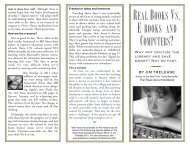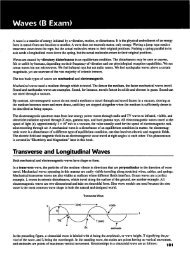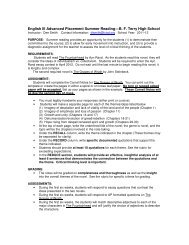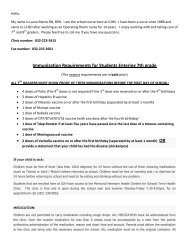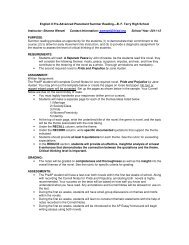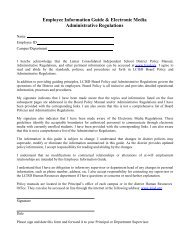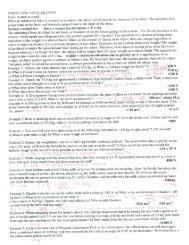Electric Force and Electric Field
Electric Force and Electric Field
Electric Force and Electric Field
You also want an ePaper? Increase the reach of your titles
YUMPU automatically turns print PDFs into web optimized ePapers that Google loves.
CHAPTE<strong>Electric</strong> <strong>Force</strong> <strong>and</strong> <strong>Electric</strong> <strong>Field</strong>As its name implies, electrostatics is the study of electric charges at rest. In this chapter,you'll look at how these charges exert forces on each other, <strong>and</strong> you'll explore the fieldconcept. You'll also learn how to calculate the electric field for some simple configurations.<strong>Electric</strong> Charge •<strong>Electric</strong> charge is a fundamental property of many of the basic constituents of matter. Thereare two types of charge—positive <strong>and</strong> negative. Charge is a quantized entity, which meansit has a fundamental unit that cannot be subdivided. The electron carries a negative chargeequal to this basic unit, while the proton carries a positive charge equal to this unit. Thevalue of this basic unit ise= 1.6 X 10~19CHere C is short for Coulomb, the SI unit of charge. Any macroscopic amount of chargemust be an integral multiple of the basic unit.Coulomb's Law<strong>Electric</strong> charges exert forces on each other. Like charges (++ or ) will repel each other,<strong>and</strong> unlike charges (+—) will attract. For two point charges qx <strong>and</strong> q2, this force acts alongthe line connecting the two charges, is directly proportional to the product of the twocharges <strong>and</strong> is inversely proportional to the square of the distance between the two. Insymbols (figure 1), the force exerted on q2 by qx is•<strong>Electric</strong> <strong>Force</strong> <strong>and</strong> <strong>Electric</strong> <strong>Field</strong>
advantageoRFigure 1Here R is a unit vector directed along the line connecting the two point charges. The forcelaw, known as Coulomb's law, also describes the force between two spherical charges whereR is the distance between the centers of the two charges.Three charges are arranged along the x-axis: +3 fiC at the origin, —2 /iC atx = —2 m, <strong>and</strong> —4 /iC at x = +3 m. Find the net force on the charge at theorigin (figure 2).(-2,0) (0,0) (3,0)-4fiCF_ 2-»3F-4+3Figure 2The +3 juC charge will experience a force in the —x direction due to the — 2//C.The magnitude of this force is= 9 X_ l37 x 10-2The +3/*C charge will experience a force in the +x direction due to the — AftC.The magnitude of this force is= 9 XThe net force will point in the —x direction <strong>and</strong> have a magnitude equal tothe difference of the two contributions.netF= 1.5 X 10"3NChapter 10
Physics B ReviewBecause both charges <strong>and</strong> vector components can carry a minus sign, it's easy to make signerrors in calculating electric forces. To guard against that, use the process from the example.First, find the magnitude of the force contribution, which is always positive, <strong>and</strong> then useyour diagram to combine the different contributions with the correct signs.<strong>Electric</strong> <strong>Field</strong> •How is it that two charges separated by a distance can exert forces on each other? How doesone charge know about the presence of the other? The answer lies in the field concept. Eachcharge creates an electric field in the space surrounding it. Another charge placed at somepoint will experience the field created by the first charge at that point. But the field at thatpoint exists whether a charge is there to experience it or not. The electric field created by adistribution of charges is defined in terms of the force that a test charge would experience ifit were placed at some point. A test charge is defined as a positive charge that's so small thatits presence doesn't change the original charge distribution. Specifically, that isr.fitThe SI units for electric field are -£k When an electric field is created solely by charges at rest,it's called an electrostatic field. In principle, you can measure the field at any point inspace by placing a small positive charge at that point <strong>and</strong> measuring the force exerted on it.You can use the definition of the field to determine the field created by variousdistributions of charge. The simplest <strong>and</strong> most important is the field created by a single pointcharge. Imagine a positive charge Q (figure 3). By symmetry, the magnitude of the field willdepend only on the distance from the charge, <strong>and</strong> the direction will be^radially outward. Ifyou bring a test charge to some point a distance R away, you have for E :<strong>Electric</strong> <strong>Force</strong> <strong>and</strong> <strong>Electric</strong> <strong>Field</strong>
This is the formula for the field created by any point charge. It's also valid for the fieldcreated by a spherical charge for points outside of the charge. As mentioned earlier, thedirection of the field is radially outward for a positive charge. If Q is negative, the field willbe radially inward. The concept of electric field lines will help you visualize the field.These are continuous lines that begin on positive charges, end on negative charges, <strong>and</strong>satisfy two criteria:1. The electric field at a given point is tangent to the field line that passes through that point.2. The density of field lines at a point is proportional to the strength of the electric fieldat that point.You'll find some examples in figure 4.<strong>Field</strong> lines start on + charges <strong>and</strong> end on -charges.The electric field is tangent to field lines.Figure 4<strong>Field</strong> Due to Point Charge DistributionsIf several point charges are present, you can calculate the total field using the principle ofsuperposition. This principle states that the total field at a point can be determined byfinding the contribution that each individual charge would make if it were the only chargepresent, then vector-adding all the contributions. For the principle of superposition to applyto a theory, certain conditions must be met by the laws that underlie the theory. Withoutgoing into the mathematical detail of the conditions, let s simply say that this principle canbe applied to both electricity <strong>and</strong> magnetism.Chapter 10
Physics B Review-4//C2//CFigure 5A -4 fiC charge is located at the point (0, 3), <strong>and</strong> a +2 ^C is located at the point(2, 0). Find the total electric field, magnitude, <strong>and</strong> direction at the origin (figure 5).You can find the field created by each charge separately, <strong>and</strong> then combine themusing vector addition.L4 = 9X 109 (4 X31°"6) = 4 X 103 £ (+y direction)£+2 = 9 X 109 (2 X21°"6) = 4.5 X 103 -g- (-x direction)You can use basic trigonometry to find the magnitude <strong>and</strong> direction.E = E\2 = 6.02 X 1Q3= %7 = l^Motion of a Charge in an Eleqric <strong>Field</strong>If you happen to know the field at a given point, you can use the definition of an electricfield to find the force on a charge that's placed at the point, assuming the introduction of thecharge doesn't change the local charge distribution <strong>and</strong> the field.F" = qtThis equation gives you the force on a charge q placed at a point where the field is E.<strong>Electric</strong> <strong>Force</strong> <strong>and</strong> <strong>Electric</strong> <strong>Field</strong>
IvantaRg"EXAMPLEFind the acceleration of an electron placed at the origin in the previous example.You can find the force from the electric field, <strong>and</strong> then use Newton's second law.F= qE= (1.6 X 10~19)(6.02 X 103) = 9.63 X 10"16NF = ma9.63 X 10~16 = 9 X 10"31 aKEYFORMULASCoulomb's Law<strong>Electric</strong> <strong>Field</strong>E= _£<strong>Field</strong> of Point ChargeChapter 10
PRACTICE EXERCISESSection I Multiple ChoiceQuestions 1 <strong>and</strong> 2. Two charges are arranged on the corners of a square as pictured.Figure 61. The direction of the net electric field at the center of the square is(A) t (B) - (C) 1 (D) / (E) /2. The magnitude of the field will be strongest at(A) A (B) B (C) C (D) D (E) E-QO :Figure 7R3. The figure shows an isolated negative charge fixed in position. Point R is 3 times as faraway as point 5. The ratio of the field strength at S to the field strength at./? is(A) 9 to 1 (B) 3 to 1 (C) 1 to 9 (D) 1 to 3 (E) 1 to 14. A 2 //C charge with mass 0.1 kg accelerates at 2 m/s2 in a uniform electric field. Themagnitude of the field is most nearly(A) lO'-g- (B) r (C) Lr<strong>Electric</strong> <strong>Force</strong> <strong>and</strong> <strong>Electric</strong> <strong>Field</strong>
'L.J,'.advantage-"50+2Q-O"DAEFigure 8B5. Charges +2Q <strong>and</strong> — 5Q are situated as shown. At what point could the electric field beequal to 0?(A) A (B) B (C) C (D) £> (E) E6. Starting from rest a charge moves a distance d along uniform field lines after which it hasa speed v. If an identical charge moves from rest through a distance 2d along the samefield lines it will have a speed of(A) jp (B)jv (C) 4lv (D) 2v (E) Av7. Charge q with mass m is a distance R from a second charge 2q with mass 2m. If F <strong>and</strong> aare the force <strong>and</strong> acceleration of the first charge, the force <strong>and</strong> acceleration of the secondcharge are(A) F <strong>and</strong> 2a (B) 2F <strong>and</strong> a (C) 2F <strong>and</strong> y a (D) 2F <strong>and</strong> 2a (E) F <strong>and</strong> y aPRACTICE EXERCISESSection II Free Response1. Two charges are located along the x-axis, —3 //C at the origin <strong>and</strong> +6 fiC, at thepoint (2, 0).(a) Determine the electric field at the point (—1, 0).(b) Find the magnitude <strong>and</strong> direction of the force on an electron placed at (— 1, 0).(c) Determine the point on the x-axis where the electric field is 0.Chapter 10
Physics B ReviewFigure 92. A nonconducting sphere of charge +Q<strong>and</strong> mass m is attached to a string of length L <strong>and</strong>hangs from a ceiling. When a uniform electric field directed horizontally is introduced,equilibrium is eventually established with the mass hanging at an angle 6 with respect tothe vertical. In terms of g <strong>and</strong> the given quantities, find the strength of the electric field<strong>and</strong> the tension in the string.3. A positive charge q is initially at the origin <strong>and</strong> moving with velocity v0 > 0 oppositeto a uniform electric field E directed in the negative x direction. The effects of gravityare negligible.(a) Determine the maximum coordinate x the charge attains.(b) Determine the time it takes for the charge to return to its starting point.(c) Determine the speed of the charge when it has the coordinate —x.Answers <strong>and</strong>ExplanationsMultiple Choice1. The answer is C. At the center, the field created by the top left charge is directed alongthe diagonal away from that charge, while the field created by the bottom left charge isdirected toward it along the other diagonal. Since the two fields have the same strength,the horizontal components cancel out.2. The answer is C. This point is closest to both charges, <strong>and</strong> the two separate fields createdby each charge are in the same direction—down—so there is no cancellation.3. The answer is A. The field at 5 is 3 =9 times bigger since R is 3 times further away.<strong>Electric</strong> <strong>Force</strong> <strong>and</strong> <strong>Electric</strong> <strong>Field</strong>
advantage--4. The answer is A. netF = ma implies qE = ma. Substituting, you getp _ (0.1 )(2) _ i n5 N.b~ 2XI0-6 ~ 1U C5. The answer is B. At this point, the two separate fields oppose each other. Because B iscloser to the smaller charge, the effect of the smaller charge can be large enough to offsetthe field due to the bigger charge. At C, the two fields oppose each other but can nevercancel out due to the proximity to the larger charge. At A, D, <strong>and</strong> £, the fields reinforceeach other.6. The answer is C. Since F = qE is constant, the second charge has twice as much workdone on it by the field. Thus, it will have twice the KE as the first charge.jmv'2 = 2(jmv2) =>«/' = VTv7. The answer is E. Each charge exerts an equal but opposite force on the other. Since theforce on the second is the same, it will have y the acceleration since it has twice the inertia.Free Response1. (a) The field due to the —3 fxC charge points in the +x direction <strong>and</strong> has magnitudeio 9 p x = 2.7 x io 4 £The field due to the other charge points in the — x direction with magnitude£+6 = 9 X IO9 (6 x'°"6) = 0.6 X 104 £The overall field points in the +x direction with magnitudeE = (2.7 - 0.6) X IO4 = 2.1 X IO4 £(b) An electron placed at this point will feel a force in the opposite direction to the field,the —x direction. The magnitude will beF= qE= (\.6X 10~19)(2.1 X IO4) = 3.4 X 10"15 N(c) Between the two charges on the x-axis, the two fields will reinforce each other. To theleft of the origin, closer to the smaller charge, the fields tend to cancel out, <strong>and</strong> if thepoint is chosen properly, the two contributions will cancel out. This will occur atsome point x < 0.Chapter 10
Physics B Review3 x IP"6 _ , 6 X IP"6= k (2 - x)2=>* =1-V2= -4.83 mOnly the — root gives a negative x-value.2. This is an equilibrium problem. You can find the net force components in each direction<strong>and</strong> set them equal 0 to get the two unknowns.From the freebody diagram (figure 10), you havewmgFigure 10i .netFx = 0 netFy = 0Tcos0-mg-Tsin0 = qETcos6 = mgDividing the two equations gives youE = tan 6The tension is given directly from the ^-components:T = cos 6<strong>Electric</strong> <strong>Force</strong> <strong>and</strong> <strong>Electric</strong> <strong>Field</strong>
advantage3. (a) The acceleration of the charge follows from Newton's second law.qE .netF = ma = qE => a = — (in — x direction)mThe fourth motion equation can be used to determine the maximum x-coordinate.v2 =m2qE(b) Since the static electric force is conservative, the charge will return to the origin withthe same speed but in the opposite direction. The first motion equation will then givethe time.v = v0 + at2mv0mqE(c) Use the fourth motion equation.v2 =v = vn -.mvnm m I 2qEv =Chapter 10



